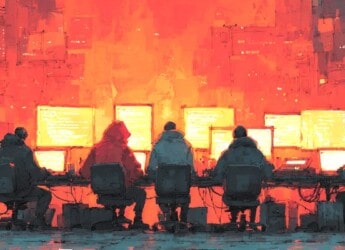Editor’s Note: Drone warfare is reshaping battlefields, while narrative campaigns and legal posturing increasingly dictate strategic outcomes. This assessment, grounded in the August 22, 2025, update by the Institute for the Study of War (ISW), explores the multidimensional nature of the ongoing Russo-Ukrainian conflict—from tactical ground operations and precision strikes to the high-stakes information war and diplomatic maneuvering that define the current phase.
Informed by ISW’s detailed operational reporting and enriched by analytical framing from ComplexDiscovery, the focus extends beyond territorial movements. It highlights the interplay of unmanned systems, legitimacy challenges, and the evolving legal and strategic environment in which both nations now operate. Designed for professionals at the intersection of national security, law, and intelligence, this synthesis offers insight into how modern war is being fought across borders, domains, and narratives.
Content Assessment: Precision and Perception: Drone Warfare and Information Battles in the Russo-Ukrainian Conflict
Information - 94%
Insight - 95%
Relevance - 92%
Objectivity - 94%
Authority - 95%
94%
Excellent
A short percentage-based assessment of the qualitative benefit expressed as a percentage of positive reception of the recent article from ComplexDiscovery OÜ titled, "Precision and Perception: Drone Warfare and Information Battles in the Russo-Ukrainian Conflict."
Background Note: ComplexDiscovery’s staff offers distinctive perspectives on the Russo-Ukrainian war and Middle Eastern conflicts, informed by their military experience on the West German, East German, and Czechoslovakian borders during the Cold War, as well as in Sinai as part of Camp David Accord compliance activities, during the timeframe of the Persian Gulf War. This firsthand regional knowledge has been further enhanced by recent staff travels to Eastern European countries, including Estonia, Finland, Latvia, Lithuania, and Poland. These visits have provided up-to-date, on-the-ground insights into the current geopolitical climate in regions directly impacted by the ongoing conflict.
Combined with cybersecurity, information governance, and eDiscovery proficiency, this multifaceted experience enables comprehensive analysis of these conflicts, including the critical impact of cyber warfare, disinformation, and digital forensics on modern military engagements. This unique background positions ComplexDiscovery to provide valuable insights for conflict-related investigations and litigation, where understanding the interplay of technology, data, and geopolitical factors is crucial.
Russo-Ukrainian Conflict Update*
Precision and Perception: Drone Warfare and Information Battles in the Russo-Ukrainian Conflict
ComplexDiscovery Staff
As the Russo-Ukrainian War grinds on, the front lines may shift only incrementally, but the dimensions of the conflict continue to evolve with profound geopolitical and strategic consequences. On August 22, 2025, new Ukrainian battlefield gains, intensified drone strikes deep into Russian-controlled territories, and Moscow’s entrenchment in diplomatic deflection formed the backdrop to a war increasingly fought in both the physical and cognitive domains.
Russia’s repeated refusal to engage in direct negotiations with President Volodymyr Zelensky, reaffirmed by Foreign Minister Sergey Lavrov’s August 22 interview, underscores Moscow’s strategic inflexibility. Lavrov not only denied the feasibility of a Putin-Zelensky summit in the near future but also accused Kyiv of failing to accept Russia’s preconditions—particularly on territorial concessions. Despite Zelensky’s stated readiness to discuss these matters without conditions, the Kremlin has consistently avoided engagement, likely fearing that any negotiation would erode its wartime narrative of irreversible victory.
This narrative positioning aligns with Russia’s broader doctrine of information warfare, which has long been analyzed by ComplexDiscovery as an essential element of hybrid conflict. The Kremlin’s strategy to delegitimize Ukraine’s elected government—evident in Lavrov’s characterization of Zelensky as “pretending to be a leader”—serves not only to sabotage diplomatic credibility but to provide Russia with rhetorical cover for future violations of any hypothetical agreements. The goal is twofold: to fracture Western unity by questioning Ukrainian legitimacy and to prepare domestic audiences to reject compromise under the guise of legality.
In parallel to these diplomatic maneuvers, Ukraine continues to wage an increasingly effective long-range strike campaign. On August 21 and 22, Ukrainian drones struck the Unecha oil pumping station, a critical component of the Druzhba pipeline network that supplies Russia’s military-industrial complex. In occupied Donetsk Oblast, Ukraine’s forces targeted a Russian command post belonging to the Rubikon Center for Advanced Unmanned Technologies and a large ammunition depot. Meanwhile, in Crimea, a Ukrainian Navy strike on Khersones Airbase destroyed multiple Iranian-manufactured Mohajer-6 and Russian Forpost drones.
From a technological warfare perspective, ComplexDiscovery has highlighted the evolution of unmanned systems in modern conflicts, and Ukraine’s actions in this regard reflect this trajectory. These strikes not only degrade Russian logistics and ISR (intelligence, surveillance, reconnaissance) capacity but signal Ukraine’s maturing ability to integrate ISR with kinetic effects at strategic depth. Russia, for its part, has sought to keep pace through innovation, using Orlan-10 “mothership” drones to extend the reach of first-person view (FPV) drones—tactics reminiscent of adaptive drone swarming and proxy delivery systems explored in Western defense literature.
This intensification of asymmetric warfare coincides with a critical humanitarian development. Ukrainian authorities successfully repatriated 65 civilians, including ill and elderly individuals, abandoned by Russian occupation authorities at the Russia-Georgia border. These civilians, many of whom had resisted Russification campaigns, were reportedly held for months in unsanitary conditions. As ComplexDiscovery has frequently noted, such forced deportations could bear significant implications under international humanitarian law—potentially constituting violations of the Fourth Geneva Convention. The legal footprint of such actions may extend well beyond the battlefield, framing future accountability mechanisms and shaping Ukraine’s post-war legal strategy.
On the tactical front, battlefield dynamics were marked by positional fluctuations rather than sweeping offensives. In northern Sumy Oblast, Ukrainian forces reportedly liberated Varachyne, while Russian units advanced in Yunakivka. Fighting also intensified in Kharkiv and Luhansk oblasts, though without confirmed Russian gains. In Donetsk, limited advances by Russian forces were observed near Chasiv Yar and Yalta, while Ukrainian troops regained positions near Zelenyi Hai and Pokrovsk. Despite these movements, the strategic line remains largely static, defined by attrition, drone strikes, and probing infantry assaults.
The conflict’s operational complexity has increased with the expanded use of unmanned ground vehicles (UGVs) by Russian forces for frontline logistics, particularly near Chasiv Yar. Russian tactics—consisting of persistent, small-unit assaults supported by camouflage and drones—continue across multiple axes. Yet the terrain and entrenched Ukrainian defenses near areas such as Kleban-Byk and Myrnohrad remain formidable obstacles to Russian momentum. As one Ukrainian tank commander reported, the Russian command is expending manpower at a considerable rate, suggesting a war effort driven more by compulsion than coherence.
Meanwhile, in Zaporizhia and Kherson oblasts, Russia’s efforts remain geographically constrained. However, strategic implications loom large: satellite imagery has confirmed the construction of Shahed drone launch sites at the ruins of Donetsk Airport, less than 40 kilometers from the front. This forward positioning drastically reduces Ukrainian air defense reaction time, signaling an intent to escalate aerial pressure even if ground movements remain limited. For Ukraine, this development challenges its existing defense-in-depth doctrine and reinforces the need for layered and mobile air defense systems, a topic repeatedly underscored in ComplexDiscovery’s analysis of adaptive threat environments.
Russia’s aerial assault continues unabated. On the night of August 21–22, Russian forces launched 55 Shahed-type and decoy drones. Although 46 were intercepted, several penetrated Ukrainian defenses, damaging civilian infrastructure in Kharkiv Oblast. Such attacks reinforce the persistent threat to Ukraine’s energy and transport systems, particularly as the country braces for another winter under siege. Drone warfare has now become both a strategic lever and a psychological weapon—capable of shaping morale and resource allocation far from the contact line.
In Belarus, President Alexander Lukashenko’s conversation with U.S. President Donald Trump introduced yet another dimension to the evolving diplomatic tableau. Lukashenko proposed a moratorium on long-range strikes as a precursor to ceasefire talks. While framed as a peace initiative, ComplexDiscovery has long cautioned that such proposals risk institutionalizing strategic deception. A temporary ban on Ukrainian long-range strikes would serve to insulate Russian logistics and defense industries while placing asymmetric constraints on Kyiv. Given Russia’s prior violations of ceasefire agreements—most notably in spring 2025—any such arrangement must be scrutinized through the lens of strategic exploitation and legal enforceability.
Ultimately, the August 22 update encapsulates a conflict defined not by grand maneuvers but by multidomain complexity. The war’s current phase is characterized by overlapping strategies of attrition, information warfare, drone innovation, and legal positioning. As battlefield conditions evolve, so too does the toolkit of each belligerent: from Orlan-10 motherships to repatriation campaigns, from Shahed drone salvos to narrative discreditation.
Ukraine’s resilience lies in its synthesis of kinetic resistance, technological adaptation, and legal-democratic legitimacy. Russia’s challenge is to sustain a narrative of inevitable victory while facing material constraints, operational inertia, and increasing international scrutiny.
The question remains: In a war where perception is as vital as territory and where legality intersects with lethality, what new paradigm will define the next phase of this grinding conflict?
Detailed Reporting with Maps for August 22, 2025, from the ISW – Mouseover to Scroll
Russo-Ukrainian War August 22 2025 - UpdateReview the Detailed Reporting and Maps PDF
About the Institute for the Study of War Research Methodology
ISW’s research methodology relies on both primary and secondary sources, enabling researchers to develop a comprehensive understanding of the situation on the ground. In order to analyze military and political developments in any given area, ISW’s research analysts must wholly understand the systems of enemy and friendly forces. They must also understand the population demographics, physical terrain, politics, and history of that area. This lays the analytical foundation for understanding the reasons for particular developments and fulfilling their assigned research objectives. ISW analysts also spend time in places like Iraq, Afghanistan, and elsewhere in order to gain a better understanding of the security and political situation and to evaluate the implementation of current strategies and policies. Their researchers compile data and analyze trends, producing a granular analysis of developments in areas of research, producing an accurate, high-resolution, timely, and thorough picture of the situation. ISW’s research methodology guarantees its success and commitment to improving the nation’s ability to execute military operations, achieve strategic objectives, and respond to emerging problems that may require the use of American military power.
About the Institute for the Study of War
The Institute for the Study of War advances an informed understanding of military affairs through reliable research, trusted analysis, and innovative education. They are committed to improving the nation’s ability to execute military operations and respond to emerging threats in order to achieve U.S. strategic objectives. ISW is a non-partisan, non-profit, public policy research organization.
Learn more, get involved, and contribute today.
Assisted by GAI and LLM Technologies
* Sourced and shared with direct expressed permission from the Institute for the Study of War (ISW).
Additional Reading
- From Dissent to OSINT? Understanding, Influencing, and Protecting Roles, Reputation, and Revenue
- Data Embassies: Sovereignty, Security, and Continuity for Nation-States
Source: ComplexDiscovery OÜ


























